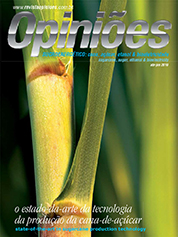Miguel Angelo Mutton e Marcia Justino Rosini Mutton
Professors of Vegetal Production and Technology Department of Unesp
Op-AA-24
Maturators
The maturation of sugarcane can be characterized according to different viewpoints: botanical, physiological or agro-industrial. From the botanical viewpoint, sugarcane is mature when it is capable of producing another plant, which in a sexual reproduction occurs after the formation of seeds, or in a non-sexual (vegetative) reproduction when the buds are ready to germinate.
From the physiological viewpoint, maturation can be defined as a continuous process involving the synthesis of sugars on the leaves, the translocation and the storing of such photosyntates in the culm, until the maximum storage potential is reached. The highest saccharose accumulation takes place when the plant faces stress conditions, such as hydric deficiency and very low temperatures that limit its growth, although it continues to store photosyntates, increasing concentration in the culm.
In the Southeast region of Brazil, this process occurs naturally beginning in April/May, reaching its maximum in September/October. From the agro-industrial viewpoint, the plant can be considered mature from the moment when the plantation shows higher sugar productivity, allowing higher industrial performance and satisfactory economic results.
During the culture’s development, the plant shows its genetic characteristics resulting from the envi-ronmental conditions it faces (temperature, solar radiation, precipitation, humidity, and soil fertility), allowing for growth and maturation periods according to the combination of these factors. When optimal precipitation, temperature and solar radiation occur, one observes vegetative growth with the subsequent formation of leaves, culms and roots.
Lacking more ideal conditions, the plant limits its growth, changes its basic metabolism, channels the photosyntates produced to the storage tissue and intensifies its maturation. When planning foresees starting the harvest in March/April and finishing in November/December, the months with more favorable conditions for sugarcane growth, one can normally observe low sugar levels in juices, even in precocious or late varieties.
From this perspective, in order to maximize sugar productivity per area and mainly industrial performance in those periods, it is necessary to apply chemical maturators to the varieties, thereby allowing to anticipate maturation to the beginning of the harvest or to have it occur at the end of the harvest. These products usually perform by temporarily limiting the plant’s growth, without affecting the photosynthesis process, while influencing the activity of enzymes directly or indirectly involved in the accumulation of saccharose in the culms, anticipating maturation.
The most commonly used maturators are: trinexapac-ethyl, sulfometuron-methyl, glyfosate and ethephon, in addition to other chemical products. One should also emphasize the possibility of using products whose composition has nutrients such as potassium, boron and organic compounds. The increase in saccharose content, due to the application of maturators, may vary depending on the product used, time of application and harvesting, the overall conditions of the sugarcane plantation, climate, soil, varieties, among other factors.
Results from experiments, consolidated in commercial areas, show that the adequate use of maturators brings about the anticipation of the plantation’s maturation, with increases between 0.5 and 1.0% in the sugarcane pol percentage, mainly in the period of 4 to 7 weeks fol-lowing application. In general, sugarcane treated with a maturator in March shows better results than if treated in April.
Increments in the pol figure allow for increases in the magnitude of 3.7 to 7.5 kilograms of sugar or 2.8 to 5.6 liters of ethanol per ton of processed culms. Thus, con-sidering an average productivity of 85 t/ha, one achieves increases per area of 320 to 640 kg of sugar, or 240 to 480 liters of ethanol. One should also consider the possibility of using a maturator at the beginning of the over-mature sugarcane harvesting.
This raw material has suckers, lateral buds and aerial roots that adversely affect quality and industrial performance, and should be harvested right at the beginning of the harvest. Bud sprouting is usually intense in these plantations, at a time when they are still immature. Using a maturator seeks to make culm maturation uniform, allowing the production of raw material with better industrial performance.
Applications at the end of the harvest usually occur in September/October, when the rain season begins. In this case, the intended effect is to slow down the decrease in sugarcane pol percentages, upholding maturation for a longer period. This allows processing a better raw material and hence, of better industrial performance. Results achieved in this period are lower than at the beginning of the harvest, but they are also more significant. Thus, one can see that the appropriate use of chemical maturators is an important tool in managing the harvesting process, aiming at maximizing raw material utilization and its industrial processing, allowing for better economic returns that contribute to the sugarcane industry’s sustain-ability.




